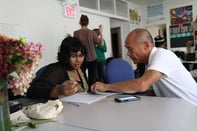Published on
What Students Need To Know About The Culture of Being Corporate

Community colleges are at the forefront of developing programs that focus on what employers are looking for, but there is still work to be done. The best option right now is to mirror the environment found in the workforce as closely as they can.
The EvoLLLution (Evo): Why are so many higher education leaders focusing more on corporate engagement today?
Shannon Bryant (SB): Business and industry are changing every day. Technological advances are taking place around us. I’m sitting in my office overlooking the Alliance Airport in North Fort Worth, which is an airport that focuses primarily on flight services including air cargo, corporate and government aviation. They’re always advancing and taking their product to the next level. The Dallas Fort Worth Metroplex has become a major attraction for businesses, specifically businesses that focus on innovation. I have a podcast through Tarrant County College called The Workforce Lens and publish a magazine for the college called The Lens, which are both focused on workforce and economic development issues.
This week I interviewed the CEO of a business that moved to Fort Worth from Los Angeles a few years ago. It’s a tech company that designs and installs automated call answering systems. Their business is the world of artificial intelligence. They have engineers on their team who spend every day researching and developing more advanced technology. And businesses like his need talent. Businesses move a lot more quickly these days. Educational institutions need to be able to keep pace with this advanced technology in their educational offerings. Community colleges have the nimbleness and flexibility to do so.
Evo: How important is professional or corporate education to meeting the modern institution’s mission?
SB: It’s imperative. You’re seeing this paradigm shift from the old school of thought. We can no longer build educational programs with just the hope that students will enroll. We must let businesses drive education and collaborate with them. The workforce is impacting both sides. We need students. Businesses need employees, specifically skilled employees who are ready to work and curious to learn. Businesses want to know how to fill their talent pipeline and sustain it in the long term. Workforce education is imperative.
Evo: Historically, why have divisions offering these kinds of programs operated on higher education’s periphery?
SB: As a leader at two of the largest community colleges in the nation, I have seen a shift in workforce education. Community colleges are at the forefront of developing workforce solutions, but we still have a long way to go. Through engaging with businesses, we can advance programs based on industry need. A bridge must be built between industry and higher education.
Evo: What are the biggest obstacles workforce education leaders face in scaling programming to serve a wider audience?
SB: Leaders must recognize that they need to run programming that mirrors a business and operates at the same pace. I spent 17 years in corporate America, working in the learning and development space for the financial services industry. Transitioning to a job in higher education has come with its challenges. Institutions of higher education tend to move slowly and not be as responsive to business as the latter’s needs require. We must dig deep and engage with the business to understand their needs. We must meet businesses where they are, be nimble to change and customize offerings based on employer demand. We must also think outside of the box in traditional higher education goals. To respond and engage with businesses, we must hire individuals who know how to work with the business community and recognize the urgency of workforce demands.
Evo: What steps can leaders of corporate education divisions take to ensure their divisions are positioned to support the strategic growth of their institutions?
SB: These are my top five:
- We as a higher education institution, need to engage, listen, interact and work side by side with business and industry.
- We need to help businesses develop career pathways that align with workforce education programs. For example, the financial services industry clearly lays out a plan for individuals starting their career. New hires are presented with a pathway of licensing exams and professional designations that need to be earned within their first years of employment. This type of model needs to go across all industries. With new and younger generations entering the workforce, it’s no longer just about the job—it’s about the lifestyle. Younger folks want to know what type of lifestyle and work-life balance a job will give them.
- We need to delineate pedagogy from andragogy. Adult learners are more self-directed and need to learn according to their learning preferences. A 40-year-old does not learn in the same way as a 14-year-old. Workforce education learning and development need to adjust as such.
- We need to focus on experiential skills-based programming. Workforce education cannot just be theory-based. It should be hands-on and relevant to the work.
- We need to not only focus on technical skills but also on essential skills (aka soft skills). Essential skills include communication, leadership, conflict resolution, teamwork, etc. Essential skills partnered with technical skills make for an outstanding employee!
Author Perspective: Administrator



